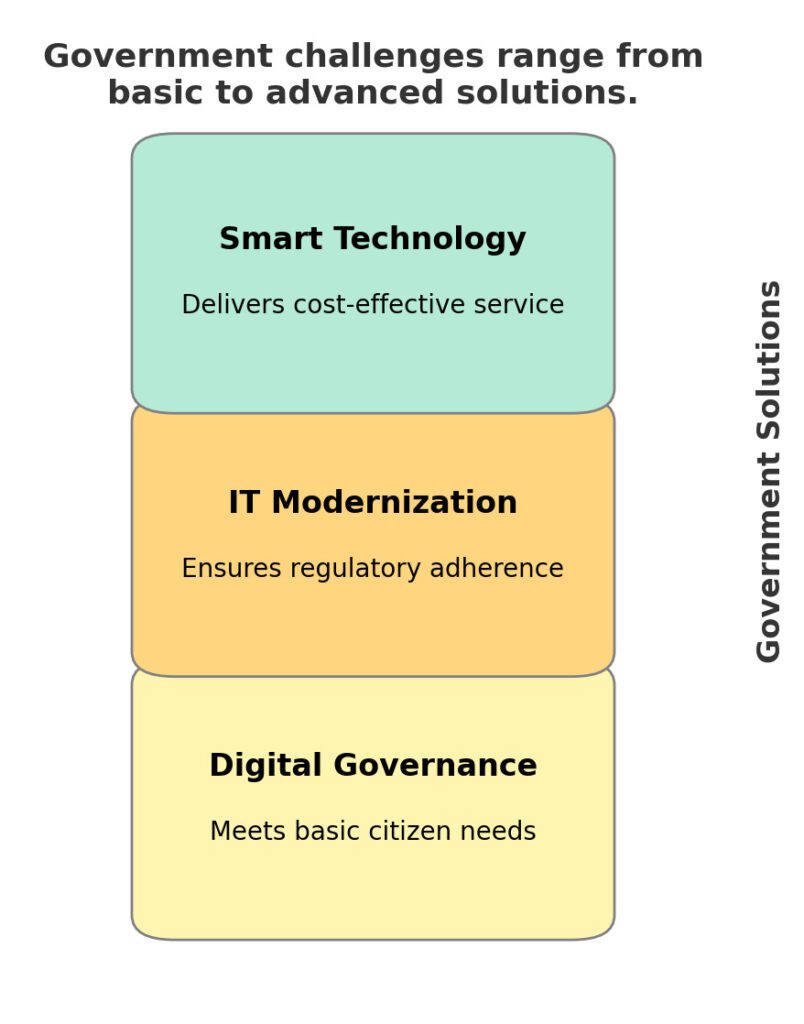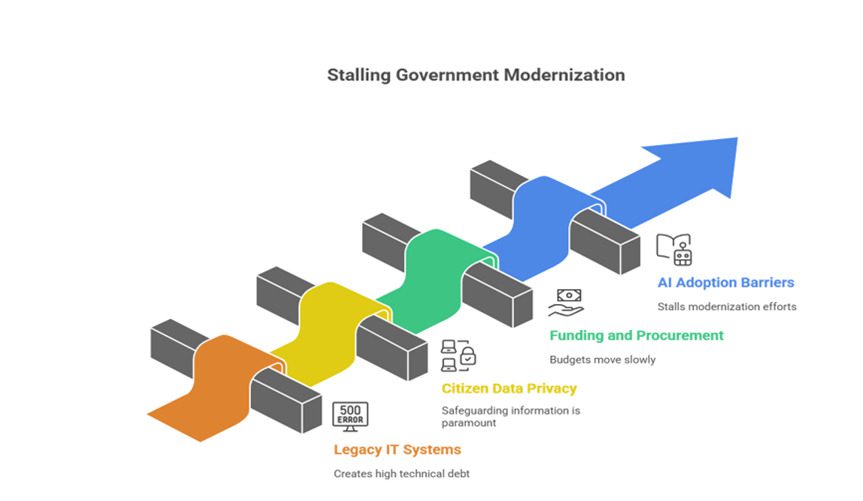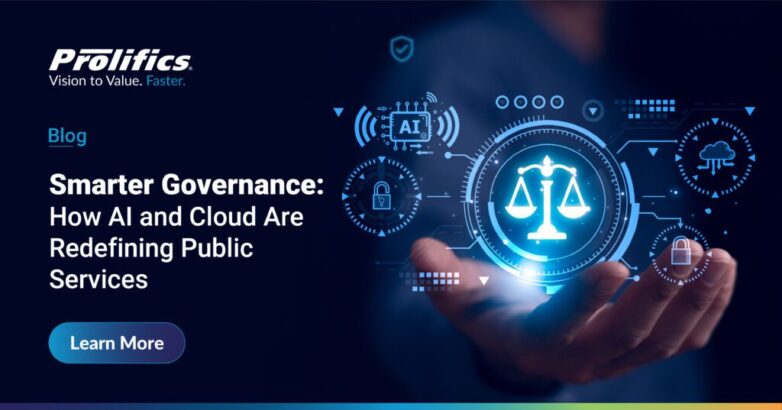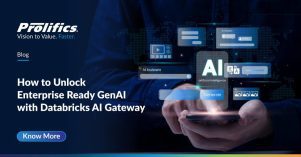Citizens today expect government services to be as fast, seamless, and reliable as their experiences with banks, retailers, or even streaming platforms. Smarter governance is no longer a concept—it’s a necessity for modern public services. Imagine renewing a passport in minutes instead of waiting months, getting real-time updates on a permit instead of standing in line at a local office, or accessing healthcare benefits online as easily as ordering groceries.
Yet outdated systems, siloed data, and manual processes often hold the public sector back. To close this gap, governments worldwide are turning to AI in government and public services and embracing cloud adoption in government to drive smarter governance and enable public sector innovation.
Together, these tools are redefining public sector innovation, enhancing efficiency, and enabling agencies to build trust with their citizens. The future of governance and the future of public administration lies in embracing smarter governance technology that balances agility with accountability. This is where organizations like Prolifics step in, helping agencies modernize responsibly and at scale.
Why Governments Need Smarter Governance in 2026 and Beyond
The call for smarter governance has never been louder. In 2026 and the years ahead, three driving forces push governments toward modernization:
1. Rising Citizen Expectations
- Citizens expect fast, mobile-friendly, and 24/7 accessible services.
- Tasks like renewing licenses or paying taxes online must be seamless.
- Without digital governance solutions, governments risk losing public trust.

2. Compliance and Transparency Pressures
- Agencies must comply with evolving regulations.
- Maintaining audit readiness and fair, data-driven decisions is critical.
- Government IT modernization ensures compliance while enabling efficiency.
3. Budget Constraints and Efficiency Needs
- Governments must reduce costs while improving service quality.
- Only smart government technology powered by AI and cloud can deliver both.
In short, the future of public administration depends on embracing digital transformation that enhances efficiency while building trust.
The Role of AI in Government & Public Sector
AI is no longer experimental in governance; it’s becoming central to agency operations. Here are five impactful applications of AI in public services in 2026 and beyond:
AI for Citizen Engagement
- AI chatbots and virtual assistants hosted on cloud platforms revolutionize service delivery.
- Citizens no longer wait in long queues or spend hours on hold.
- Multilingual support and guided processes create faster, more inclusive access to public services.
Predictive Analytics for Policy & Planning
- Cloud-based predictive AI enables smarter urban planning.
- Analyzes housing, transportation, and healthcare data to anticipate demand.
- Helps city planners forecast traffic, manage energy, and design sustainable growth strategies.
Fraud Detection & Fairness in Systems
- AI and cloud help governments detect and prevent welfare fraud.
- Real-time anomaly detection ensures benefits reach the right people.
- Reduces financial waste and increases transparency.
AI in Smart Cities & Public Safety
- Machine learning improves city management through traffic optimization, sensor-based monitoring, and emergency preparedness.
- Enhances resource management, citizen safety, and sustainability.
Ethical & Responsible AI
- Governments must follow ethical AI guidelines for cloud-based public services.
- Ensures decisions are transparent, explainable, and aligned with citizen rights.
- Prioritizing responsible AI strengthens public trust.
How Cloud Adoption in Government Enables Smarter Governance
AI cannot scale without a strong digital foundation. Cloud in government provides the flexibility, compliance, and cost savings agencies need to accelerate transformation.
Key benefits of cloud adoption in government:
- Scalability for digital services: Quickly scale during peak demand, e.g., tax season or emergency relief programs.
- Inter-agency collaboration: Secure shared platforms for departments to exchange data.
- Compliance and reporting: Automate compliance checks and audits.
- Best practices for migration: Adopt phased migration, prioritize critical workloads, and work with experienced providers.
By combining AI with cloud, governments achieve flexible, resilient, and citizen-focused digital transformation.
Challenges in AI & Cloud Adoption for Public Services
Despite the promise, adoption is not without obstacles. Common challenges include:
- Legacy IT systems. Many agencies operate with outdated systems that create high technical debt. Modernizing them is complex and resource intensive. Prolifics addresses this with proprietary accelerators like ADAM (Automated Data Migration) to streamline modernization and reduce risk.
Citizen data privacy. While data analytics in government brings powerful insights, agencies must safeguard information to maintain trust. Prolifics combines deep expertise in AI governance frameworks with secure architectures to ensure compliance while enabling innovation.

- Funding & procurement hurdles. Public sector budgets often move slowly, delaying adoption of transformative technologies. Prolifics’ global delivery model and flexible engagement structures help agencies achieve more within constrained budgets.
- AI adoption barriers in the public sector. Cultural resistance limited technical expertise, and rigid processes can stall modernization. With strong industry partnerships (IBM, Microsoft, and others) and proven change management approaches, Prolifics helps agencies accelerate adoption and build lasting capability.
Whether it’s deploying generative AI in government workflows or ensuring seamless cloud adoption in government, Prolifics provides end-to-end support to build smarter governance.
Efficiency-Driven Case Study
A U.S. state agency struggling with long delays in citizen inquiries partnered with Prolifics.
- Solution: AI-powered chatbot on cloud platforms.
- Result: Response times cut by 40%, faster citizen access to services, employees focus on complex cases.
This demonstrates how AI in government and public services delivers measurable efficiency and citizen satisfaction.
Conclusion
The next decade of public sector innovation will be defined by AI and cloud adoption.
From data analytics to AI chatbots improving citizen service delivery, these technologies form the foundation of modern governance.
With Prolifics, agencies can modernize efficiently and responsibly, delivering citizen-first services that last.




